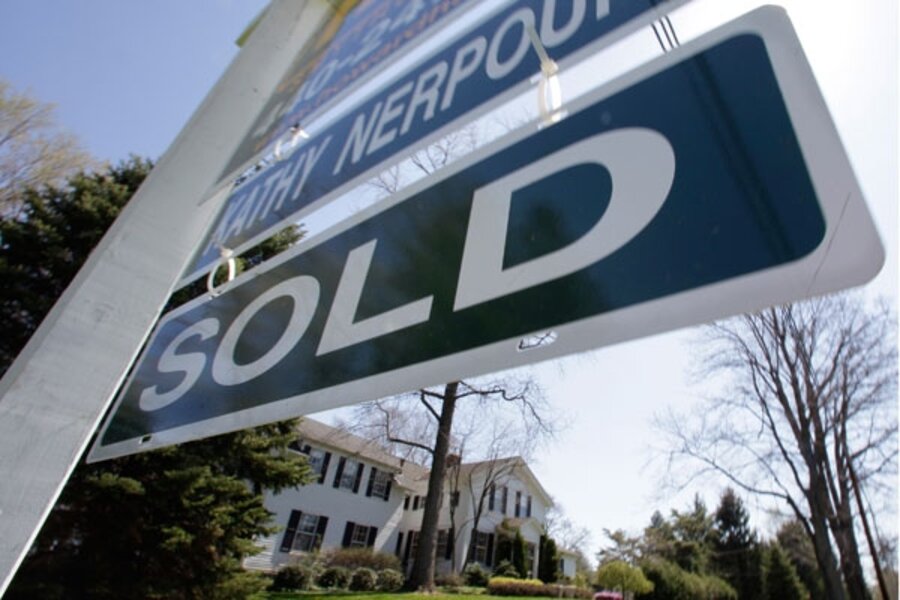Home prices less dismal, but still falling steeply
Loading...
The pace of decline in US home prices has been easing a bit, but the downward trend still persists from New York to Seattle.
That’s the message from recent housing-market numbers, including the release of the widely watched Standard & Poor’s Case-Shiller home price index Tuesday.
After months of record year-over-year declines, the new monthly report, covering February, did not show a record decline. Still, the fall in prices for 20 major cities remains steep – down more than 18 percent in the past year.
Perhaps most notable, the downward trend runs nationwide. Despite the somewhat softer pace of declines, home prices fell in February in all 20 cities. The pattern now may be more connected to the weak economy than to the popping of a bubble in once-hot markets like Phoenix.
“Housing prices … are no longer falling off a cliff. Instead, they are rolling down a steep hill,” says Patrick Newport, an economist at IHS Global Insight in Lexington, Mass., in a report analyzing the numbers.
Four once-booming states – California, Florida, Arizona, and Nevada – remain the epicenter of the housing bust. But other states are closing the gap. Seven cities in the Case-Shiller survey are in the four "bust" states. In the past year, they have seen housing prices fall by 28.2 percent on average. The 13 cities not in those bust states have seen prices drop by less than half that figure: 13.2 percent. In the last four months, however, home prices in the "bust" state cities have fallen by 12.3 percent. Cities not in the "bust" states were only marginally better off for that period, with prices falling by 9.6 percent.
Many economists expect home prices to keep falling, in part because they are still high relative to rental prices and personal incomes. But as many Americans have learned, home values aren’t automatically tied to such fundamentals.
Some keys to home prices now will be things like the unemployment rate in particular cities and the high inventory of homes for sale – an indication of more sellers than buyers.
“Housing prices will continue to drop … because foreclosures are still rising and because the number of homes on the market is near record levels,” predicts Mr. Newport.
Currently, the number of for-sale homes nationwide represents a 10-month supply for buyers, according to the National Association of Realtors. For the market to come into balance, many economists expect that the inventory level will need to fall sharply, perhaps to about a six-month supply.
Phoenix has seen its home values fall more than any other city in the Case-Shiller tallies. As of February, prices there are down 51 percent from the 2006 peak. Dallas has seen the smallest decline: 11 percent.
Even with the declines, almost all the 20 cities have home values that are above where they were in January 2000. In most cases, the increase since then is substantial – 4 percent annualized gains on average.
So far, New York tops the list of cities where prices rose high during this decade and have retained much of that gain. Prices in the Big Apple are 79 percent above where they began the decade. Prices in Washington, D.C., are up 68 percent
Not all the hard-hit cities are Sun Belt boomtowns. Cleveland and Detroit never saw a housing bubble, so now average prices are below where they stood in January 2000. In Detroit, capital of the struggling automotive industry, the drop has been steep – a 25 percent decline in prices during the decade. The decline would be even more severe if adjusted for inflation.
Several forces could help to stabilize the housing market in coming months.
One would be if the pace of layoffs declines, as many economists expect. In a survey released Tuesday by the Conference Board, consumer confidence rose sharply, in part because of declining pessimism about the job market. The consumer confidence index rose to a level of to 39.2, up from a revised 26.9 in March. That was a much stronger gain than expected.
Another boost could come from federal housing policy. The Obama administration is trying to contain the wave of foreclosures by helping more homeowners refinance their loans at affordable rates.
On Tuesday, the Obama administration announced an expansion of its housing plan, with incentives for mortgage lenders to refinance the second mortgage (as well as the primary mortgage) that many at-risk borrowers have.
Often during the boom, people bought homes with both a primary loan and a “piggyback” loan that substituted for a down payment. The Treasury Department will now offer incentives to lenders who refinance these loans. The result could be fewer foreclosures.





